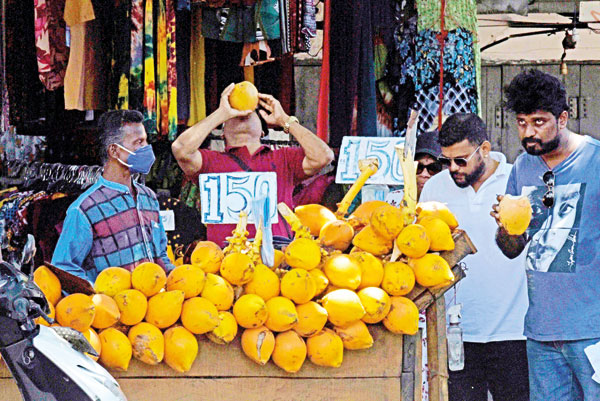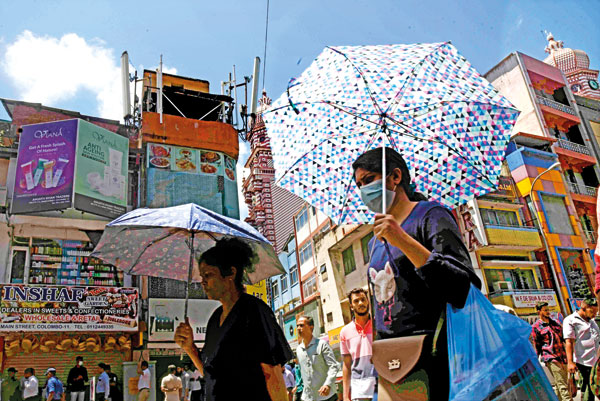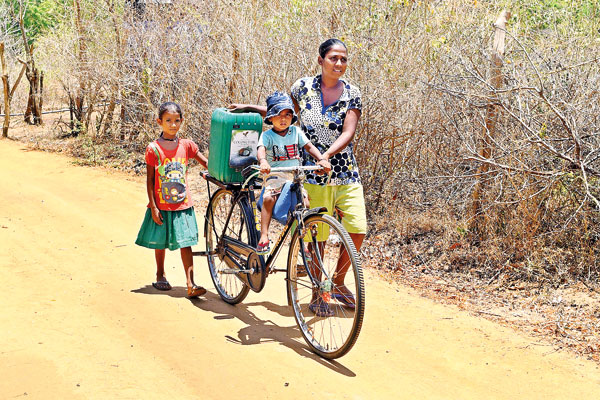News
Dehydration risks rise for infants and elderly during dry spells
View(s):By Nathara Abeywickrema
The importance of water for the prevention of nutrition-related, non-communicable diseases has emerged owing to the limitation of access to safe drinking water in the face of a prolonged dry spell, nutritionists say.
According to the Disaster Management Centre’s (DMC) latest report, 280,400 people and 81,203 families across 17 districts do not have safe drinking water. Jaffna, Ampara, and Batticaloa are the hardest hit.
Speaking to the Sunday Times, nutrition specialist Dr. Renuka Jayatissa said insufficient fluid intake during dry weather conditions could increase the risk of kidney stones and urinary tract infections. It could equally lower one’s physical and mental performance and salivary gland function, which eventually leads to dehydration that causes headaches and muscle cramps.

Experts have warned public of the importance of being adequately hydrated. Pix by Akila Jayewardana
“Anyone can undergo dehydration, but those who are at higher risk would be babies, children, and the elderly. If dehydration is not corrected by fluid intake, eventually urination stops, the kidneys fail, and the body is unable to remove toxic waste products. In extreme cases, dehydration may also result in death.”
Water is required for almost all body functions, including supporting the health and integrity of every cell in the body, keeping the bloodstream liquid enough to flow through blood vessels, carrying nutrients and oxygen to cells, etc.
It also plays a key role in balancing body temperature through sweating and moisturising mucosas, namely the lungs and mouth. Lubrication of joints and tissues, along with minimising the risk of urinary tract infections by keeping the bladder clear of bacteria, is another. Water also promotes digestion and puts a stop to constipation, medical experts say.
“Furthermore, water generally helps the body naturally attempt to eliminate substances that are harmful or are not used. When the necessary water intake is reduced, such essential functions of the body will slow down in all probability, and this will ultimately open the way for various other diseases,” warned Dr. Jayatissa.

Dr. Jayatissa said: “Normal urine is pale yellow to amber in colour and is clear. Darker urine is often a sign of dehydration. If one notices that their urine is darker than normal and has no other symptoms, their ultimate fluid intake goal should be to make their urine return to a lighter colour.”
Dr. Ananda Chandrasekara, vice president of the Nutrition Society in Sri Lanka and a professor in applied nutrition, shared his views on how water further aids in wiping out by-products of the body’s metabolism, such as excess electrolytes such as sodium and potassium, and urine, otherwise stated, a waste product brought about through the function of dietetic proteins.
He said: “Electrolyte imbalances are often caused by severe dehydration, which is known as a fast track to hypoxemia, where low levels of oxygen in the blood are found.
“Youngsters are at greater risk of dehydration than adults. Severe dehydration drives children to become lethargic. Moderate and severe dehydration can cause a fast heart rate and lightheadedness that could bring about cardiac arrest.’’
Children are more likely to adopt safe habits when they see their parents practising them. With school starting next week, protecting oneself from exposure to the sun as a means to prevent dehydration and the amount of fluid that needs to be restored during physical activity should be planned ahead of time. Therefore, parents have greater responsibility for their children in terms of maintaining adequate patterns of water intake and hydration, emphasised Dr. Chandrasekara.
Food and nutrition specialist and independent researcher Dr. Damayanthi Perera underlined that the potential impact of water scarcity, increased water consumption and a decrease in supply would likely lead to poor quality water that would act as a contributing factor in several water-borne and food-borne diseases.
“The community should always follow ways of purifying water before consumption. The most reliable way is by using water purifiers. Yet, boiling water is the cheapest and safest approach, as it is the surest method to kill disease-causing germs involving viruses, bacteria, and parasites,” she added.
Shanaka Bopitiyage, secretary of the Public Health Inspectors’ Union (PHIU), stressed that contamination can ruin a water source. PHIs are inspecting the quality of the water by collecting samples.
Mr. Bopitiyage recommended that adding a pinch of salt when cleaning fruit and vegetables prior to consumption is necessary in an effort to sidestep food-borne diseases, including dysentery. “At this point, we are instructing the public about such matters through clinics and various other related programmes.’’
Increasing consumption of watery vegetables and fruits, namely watermelon, cucumber, local oranges, king coconut, etc., can help one meet hydration needs. The nutritionist’s advice was that energy drinks can magnify the risk of dehydration, possibly because of their caffeine content.

In search of safe drinking water: NWSDB said 49 of 267 water sources are adversely impacted. Pic by Pradeep Pathirane
In the meantime, DMC Director General Ret. Maj. Gen. Sudantha Ranasinghe said: “To increase people’s resilience against drought and that of ecosystems, bold moves are vital. Adopting a complete strategy that entails hydration regardless of the aridity is more prominent.
“However, DMC is maintaining water distribution systems that ensure high-quality drinking water for the most pressing areas. In the meantime, 20 water bowsers have been released to the relevant drought-affected districts to be overseen by government agents.”
The challenge remains in streamlining the operation, maintaining it, and increasing the safety of the supply network and water quality while protecting the environment and water resources. Such instances point to the need that people, together with the government, should adopt new practices and policies to prepare in the best way possible for unavoidable drought conditions that may come about in due course, he said.
Anoja Kaluarachchi, deputy general manager of the National Water Supply and Drainage Board (NWSDB), said 49 of 267 water sources are adversely impacted.
“However, the existing situation is in hand at present through the release of water from other sources for drinking purposes, including reservoirs in Anuradhapura, Thuruwila, and Thissa Wewa,” she said.
As it stands, the NWSDB underlines that the pipe-borne coverage under its purview is at 48%, whereas the safe water coverage remains at 80%. Meanwhile, 12% of water supplies are under pradeshiya sabhas.
Mr. Kaluarachchi said the NWSDB is awaiting cabinet approval to impose an emergency situation in an attempt to ensure safe drinking water until mid-October, when rains are expected.
The best way to say that you found the home of your dreams is by finding it on Hitad.lk. We have listings for apartments for sale or rent in Sri Lanka, no matter what locale you're looking for! Whether you live in Colombo, Galle, Kandy, Matara, Jaffna and more - we've got them all!

